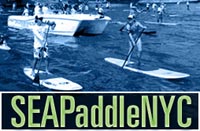 A week ago we posted about the increasing popularity of Stand-Up-Paddling (SUP) also known as paddle-boarding. The sport was new to us, but obviously we have been behind the times, at least when it comes to stand-up paddling. Last Friday, the Surfers Environmental Alliance sponsored their 4th Annual SEAPADDLE NYC, a SUP paddle and race around Manhattan (well almost all the way around.) The events raised money for eight different charities providing services to families with autism.
A week ago we posted about the increasing popularity of Stand-Up-Paddling (SUP) also known as paddle-boarding. The sport was new to us, but obviously we have been behind the times, at least when it comes to stand-up paddling. Last Friday, the Surfers Environmental Alliance sponsored their 4th Annual SEAPADDLE NYC, a SUP paddle and race around Manhattan (well almost all the way around.) The events raised money for eight different charities providing services to families with autism.
In other news, the NY Times is reporting tension between traditional surfers and the SUPers who are beginning to move from calm waters to take on the big waves with paddles in hand.
Rivalry as Stand-Up Paddlers Head to Bigger Surf
And these skillful stick men and women -– to whom we also refer as sea sweepers — can upend the traditional rhythm of a break. For starters, because they are always standing, they have a better view of incoming waves than their surfboard-bound brothers and sisters. With that edge, they can start maneuvering for prime position sooner. And because their tankers are generally much longer — and have so much more surface area — than average surfboards, they generally take off farther back on waves. Once an old-school surfer realizes a wave has arrived, a sea sweeper is likely already barreling down the newly formed line.
It is enough to drive a surfing purist batty. And indeed, it already is. We have seen signs of tension on Long Island in bumper stickers of a cartoon stand-up paddler, dressed in a clown suit, with a dreaded red X across his likenesses.
“Just because you can catch everything with that boat that you are on doesn’t mean you should,’’ Khoi Le, an expatriate of California who now lives and surfs here, told Waves contributor Tetsuhiko Endo in an interview. “We are supposed to share waves.”
(Yet, underscoring the allure of this newly popular style of surfing, he added, “Seriously, not for nothing, I want to try a stand-up paddle board.”)
After describing some harrowing near misses that she recently witnessed between stand-up surfers and traditional surfers on Eastern Long Island, Adlin Deliz, a coordinator at a New York media company, said, “It just seems very unsafe and hazardous to people who are laying down on surfboards – it’s difficult to move out of the way in time when you are riding a smaller board.”

I saw a stick figure bobbing in front of North Cove, waiting for ferry traffic to cross. This is good! Now I can jump in the river armed with a board and swim until apprehended, and just tell the harbor police I fell off the board.
Why not just claim to be a mermaid?